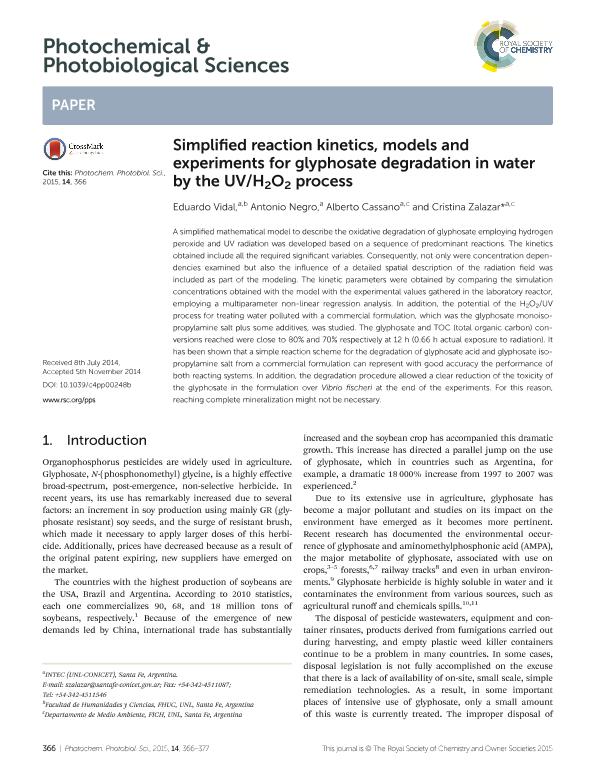Artículo
Simplified reaction kinetics, models and experiments for glyphosate degradation in water by the UV/H2O2 process
Vidal, Eduardo Gabriel ; Negro, Antonio Carlos
; Negro, Antonio Carlos ; Cassano, Alberto Enrique
; Cassano, Alberto Enrique ; Zalazar, Cristina Susana
; Zalazar, Cristina Susana
 ; Negro, Antonio Carlos
; Negro, Antonio Carlos ; Cassano, Alberto Enrique
; Cassano, Alberto Enrique ; Zalazar, Cristina Susana
; Zalazar, Cristina Susana
Fecha de publicación:
01/2015
Editorial:
Royal Society Of Chemistry
Revista:
Photochemical And Photobiological Sciences
ISSN:
1474-905X
Idioma:
Inglés
Tipo de recurso:
Artículo publicado
Clasificación temática:
Resumen
A simplified mathematical model to describe the oxidative degradation of glyphosate employing hydrogen peroxide and UV radiation was developed based on a sequence of predominant reactions. The kinetics obtained include all the required significant variables. Consequently, not only were concentration dependencies examined but also the influence of a detailed spatial description of the radiation field was included as part of the modeling. The kinetic parameters were obtained by comparing the simulation concentrations obtained with the model with the experimental values gathered in the laboratory reactor, employing a multiparameter non-linear regression analysis. In addition, the potential of the H2O2/UV process for treating water polluted with a commercial formulation, which was the glyphosate monoisopropylamine salt plus some additives, was studied. The glyphosate and TOC (total organic carbon) conversions reached were close to 80% and 70% respectively at 12 h (0.66 h actual exposure to radiation). It has been shown that a simple reaction scheme for the degradation of glyphosate acid and glyphosate isopropylamine salt from a commercial formulation can represent with good accuracy the performance of both reacting systems. In addition, the degradation procedure allowed a clear reduction of the toxicity of the glyphosate in the formulation over Vibrio fischeri at the end of the experiments. For this reason, reaching complete mineralization might not be necessary
Palabras clave:
Vibrio
,
Fischeri
,
Glyphosate
,
Degradation
Archivos asociados
Licencia
Identificadores
Colecciones
Articulos(INTEC)
Articulos de INST.DE DES.TECNOL.PARA LA IND.QUIMICA (I)
Articulos de INST.DE DES.TECNOL.PARA LA IND.QUIMICA (I)
Citación
Vidal, Eduardo Gabriel; Negro, Antonio Carlos; Cassano, Alberto Enrique; Zalazar, Cristina Susana; Simplified reaction kinetics, models and experiments for glyphosate degradation in water by the UV/H2O2 process; Royal Society Of Chemistry; Photochemical And Photobiological Sciences; 14; 2; 1-2015; 366-377
Compartir
Altmétricas



